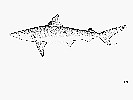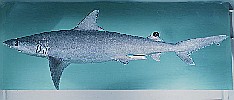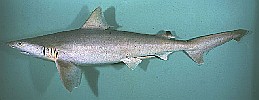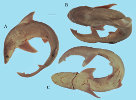Carcharhinus dussumieri
(Valenciennes in Müller & Henle, 1839)
Whitecheek shark
Classification: Elasmobranchii Carcharhiniformes Carcharhinidae
Reference of the original description
Systematische Beschreibung der Plagiostomen. Berlin, Veit, pp. 1–200
Systematische Beschreibung der Plagiostomen. Berlin, Veit, pp. 1–200
Image of the original description
.jpg)
Carcharhinus dussumieri (Müller & Henle, 1839)
.jpg)
Carcharhinus dussumieri (Müller & Henle, 1839)
Synonyms / new combinations and misspellings
Carcharhinus cf. dussumieri, Carcharias dussumieri, Carcharias malabaricus, Carcharias (Prionodon) dussumieri, Carcharinus dussumieri, Eulamia dussumieri, Squalus (Carcharinus) dussumieri
Carcharhinus cf. dussumieri, Carcharias dussumieri, Carcharias malabaricus, Carcharias (Prionodon) dussumieri, Carcharinus dussumieri, Eulamia dussumieri, Squalus (Carcharinus) dussumieri
Types
Carcharhinus dussumieri
Lectotype: MNHN: 1135; Paralectotype: MNHN: 1136; ZMB: 4464 China
Carcharias malabaricus
Syntype: AMS: I.61;
Carcharhinus dussumieri
Lectotype: MNHN: 1135; Paralectotype: MNHN: 1136; ZMB: 4464 China
Carcharias malabaricus
Syntype: AMS: I.61;
Description :
Citation: Carcharhinus dussumieri (Valenciennes in Müller & Henle, 1839): In: Database of modern sharks, rays and chimaeras, www.shark-references.com, World Wide Web electronic publication, Version 01/2026
Please send your images of "Carcharhinus dussumieri" to info@shark-references.com
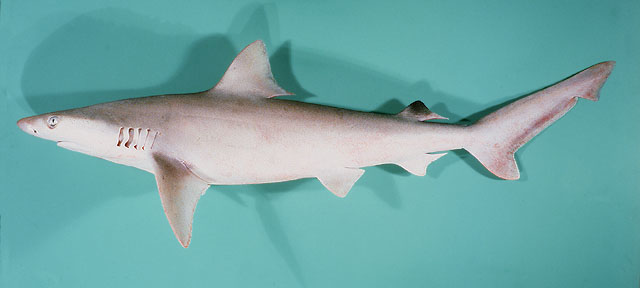
Carcharhinus dussumieri (Müller & Henle, 1839), © Randall, J.E, www.fish-base.org

Carcharhinus dussumieri (Müller & Henle, 1839), © Randall, J.E, www.fish-base.org
Common names
 Tiburón cariblanco,
Tiburón cariblanco,  Requin nene pointe,
Requin nene pointe,  Requin à joues blanches,
Requin à joues blanches,  Blacktip shark,
Blacktip shark,  Coates" shark,
Coates" shark,  White check shark,
White check shark,  White cheeked shark,
White cheeked shark,  White-cheeked shark,
White-cheeked shark,  White-cheeked whaler shark,
White-cheeked whaler shark,  Whitecheek shark,
Whitecheek shark,  Whitecheek whaler,
Whitecheek whaler,  Widemouth blackspot shark
Widemouth blackspot shark
 Tiburón cariblanco,
Tiburón cariblanco,  Requin nene pointe,
Requin nene pointe,  Requin à joues blanches,
Requin à joues blanches,  Blacktip shark,
Blacktip shark,  Coates" shark,
Coates" shark,  White check shark,
White check shark,  White cheeked shark,
White cheeked shark,  White-cheeked shark,
White-cheeked shark,  White-cheeked whaler shark,
White-cheeked whaler shark,  Whitecheek shark,
Whitecheek shark,  Whitecheek whaler,
Whitecheek whaler,  Widemouth blackspot shark
Widemouth blackspot shark
Short Description
Back grayish or grey-brown, belly whitish; a black spot on the second dorsal fin [544].
Back grayish or grey-brown, belly whitish; a black spot on the second dorsal fin [544].
Distribution
Indo-West Pacific: Persian Gulf and Arabian Sea between Gulf of Oman and Pakistan to Java, Indonesia and the Arafura Sea (Ref. 9819), north to Japan, south to Australia [1388]. Source: www.gbif.org
Indo-West Pacific: Persian Gulf and Arabian Sea between Gulf of Oman and Pakistan to Java, Indonesia and the Arafura Sea (Ref. 9819), north to Japan, south to Australia [1388]. Source: www.gbif.org
Human uses
fisheries: commercial
fisheries: commercial
Biology
Viviparous, placental [733]. With 2 to 4 pups in a litter; 37-38 cm at birth [517]. Both male and females mature at about 70 cm [1388]. Distinct pairing with embrace [17086]. No distinct seasonal reproductive cycle apparent, instead continuously breeding with most mature females pregnant or spent at any one time [2539]. A common but little-known shark found on the continental and insular inshore areas [544]. Feeds mainly on fishes but also on cephalopods, and crustaceans [1388]. A carnivore [17641].
Viviparous, placental [733]. With 2 to 4 pups in a litter; 37-38 cm at birth [517]. Both male and females mature at about 70 cm [1388]. Distinct pairing with embrace [17086]. No distinct seasonal reproductive cycle apparent, instead continuously breeding with most mature females pregnant or spent at any one time [2539]. A common but little-known shark found on the continental and insular inshore areas [544]. Feeds mainly on fishes but also on cephalopods, and crustaceans [1388]. A carnivore [17641].
Remarks
shark-references Species-ID=743;
shark-references Species-ID=743;
Parasites (arranged by Jürgen Pollerspöck)
Cestoda
Nematoda
Copepoda
Cestoda
- Anthobothrium afsanae Sadeghi Vilni & Haseli, 2024 [32555]
- Anthobothrium barsami Sadeghi Vilni & Haseli, 2024 [32555]
- Anthobothrium sp. [10852]
- Callitetrarhynchus gracilis (Rudolphi, 1819) Pintner, 1931 [15730]
- Otobothrium carcharidis (Shipley & Hornell, 1906) [15747] [15730]
- Otobothrium sp. [15730]
- Paraorygmatobothrium sp. [10852]
- Phoreiobothrium iraniense Javadi & Haseli, 2022 [30450]
- Platybothrium yanae Vaskeh & Haseli, 2024 [33254]
- Proemotobothrium southwelli Beveridge & Campbell, 2001 [15730]
- Pseudogrillotia perelica (Shuler, 1938) [15730]
- Scyphophyllidium haselii (Caira, Malek & Ruhnke, 2011) [14437]
- Scyphophyllidium mobedii (Malek, Caira & Haseli, 2010) [11249]
- Scyphophyllidium sinuspersicense (Malek, Caira & Haseli, 2010) [11249]
Nematoda
- Huffmanela sp. [30038]
Copepoda
- Perissopus dentatus Steenstrup & Lütken, 1861 [16569] [15303]
- Pseudopandarus australis Cressey & Simpfendorfer, 1988 [16579] [16569] [25052]
- Pseudopandarus longus (Gnanamuthu, 1951) [15303] [25052]








